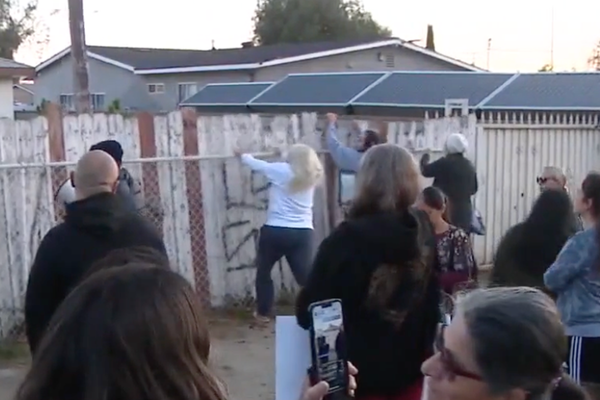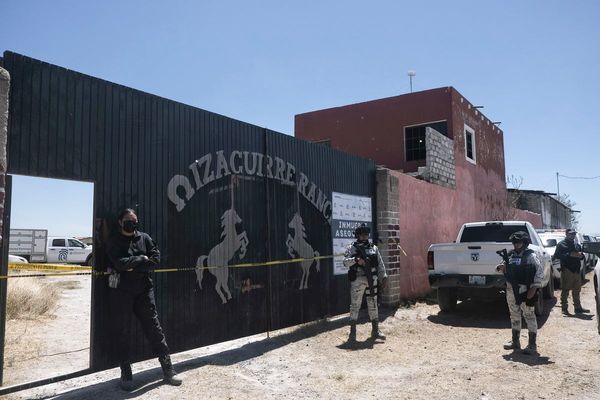It's a Saturday in mid-September and the man in an ankle-length purple velvet coat looks no more out of place at the Fleece Inn than the woman dashing past in traditional Morris dancer garb, her shoes jingling like sleigh bells. A hush falls over the crowd as a musician in a feathered top hat leads a procession through the courtyard, banging a drum to mark the entrance of a bride in a cerulean dress.
“It’s a pagan ceremony,” Nigel Smith murmurs quietly to the people next to him. His explanation is met with a chorus of understanding “ohs” that drift into a respectful silence as they watch the wedding party move into the barn. “They’re having it in a circle of green leaves,” he adds.
Weddings, wakes, baptisms - they all take place at Nigel’s pub. He reels off the other events and groups it supports: the silver band, the village show, an annual cider festival, Nigel Night - a semi-serious charity get-together of those that share his name. When it began in 2019, more than 430 Nigels turned up, creating a world record and making national news; the next one is this weekend, just in time to celebrate 20 years since its namesake landlord moved into this National Trust-owned pub.
On the face of it, The Fleece looks like many other rural watering holes. Tucked behind Bretforton’s main road and three miles from Evesham in Worcestershire, the 19th Century building sits pretty in white-washed stone and a grapevine so well-established it threatens to take over the frontage. The interior is a warren of dark rooms slumping under timber beams, all uneven floors and low doorways that have almost certainly injured many an unobservant punter of more than average height.
“I’m just about getting used to it,” Nigel jokes drily. “You get all the benefits of living in a historic building - the aesthetics, the history of it, the social relevance of a traditional country pub, I enjoy all of that. It’s quite difficult if you want to put in a fantastic new bathroom suite - you might think twice about that as a tenant. And living above the shop it can be a bit noisy due to people having the temerity to enjoy themselves.
“But the fact I’ve been here [that long] is a testament to what a great time I’ve had. It’s a very unique place - unlike any other pub in England.”
The Fleece has been keeping the thirsts of locals quenched since farmer Henry Byrd was granted a licence to sell beer and cider in 1848. His family was so entrenched in this village on the edge of the Cotswolds that his ancestors featured in some of the earliest parish records and after he died, it passed through the hands of generations of Byrd women until 1977, when his great-great-granddaughter Lola Taplin bequeathed it to the Trust in her will.
During her 30-year custody of the pub, she famously tolerated no nonsense and her presence - both figuratively and literally - is, to some people, still very much felt. One unwritten rule is that her footwear, kept inside a former cockfighting settle that now doubles as a dining bench, should not be removed. When asked if an exception could be maid, a barmaid recoils.
“Oh, no. The last time we had them out there was a major fire.”
There is perhaps good reason to be superstitious at the Fleece. Though it has been a pub for almost 175 years, the history of the site dates back to the 15th Century, when part of the original building was a longhouse that sheltered a farmer and his livestock.
Nigel is stoic that after 600-plus years it’s entirely possible people “might have ended up haunting the place”, though the actions of his predecessors have perhaps helped mitigate it. Lola, for example, kept up the tradition of maintaining “witches circles” in front of the fireplace - white rings on the hearth once regularly drawn on with a donkey stone but now permanently painted on.
“The idea is that the evil spirits come down the chimney and are mesmerised by the circles and they get stuck inside them, therefore keeping the building free of evil spirits… and I have to say we get very little poltergeist activity,” Nigel explains.
“But things get thrown about a bit [from time to time] if there’s a bit of disquiet in the team, glasses get pushed off shelves… but that’s just playing up. Maybe it’s Lola making her presence known.”
Her shoes, however, still rattle nerves. Nigel has always thought it best to leave them alone but recalls how someone once got them out and within a few seconds a saucer was hurled across the bar.
“It didn’t just fall, it flew across the bar… and I wasn’t the only person who saw it.”
Despite this - and the part the shoes might have played in a devastating fire that almost destroyed the Fleece in 2004 - Nigel is willing to reveal the shoes, albeit briefly. At the base of the settle is a cupboard where birds would have been kept before a fight; now they house Lola’s pumps, grey with cobwebs and dust. He shuts them back up where they can do no harm and winds up a grandfather clock next to a dresser filled with Worcestershire pewter.
“There was a rumour it was left by Cromwell but it wasn’t made until about 30 years after he died,” says Nigel of the vast dinner service. “My theory was that one of the lords of the manor was a gambler and used Lola as a pawnbroker.”
He describes how shortly after Lola died the pewter was briefly stolen, only to be returned swiftly within days of the news getting out, presumably by someone with an attack of conscience.
It seems that in every corner of the Fleece there is an interesting and unusual artefact with a story attached, all of them saved by Nigel and the quick actions of villagers. When the thatched roof went up in flames, residents not only formed a chain to rescue the pub’s artefacts but supported its landlord in the long months afterwards when he served drinks out of the barn.
“It was touch-and-go for a while but the Trust reacted very strongly in terms of engaging with the local community and we worked together to rebuild the place over a 15-month period,” says Nigel.
“The feeling of coming together and the amazing support from the regulars that we were given… there was a sense of community that I’ve always felt grateful for.”
It's believed that the Fleece was the National Trust’s first single public house when it passed into its ownership in 1978, a year after Lola bequeathed it to them. It was a departure from its typical portfolio of country houses and historic buildings and it had a difficult decision to make when faced with the £1m restoration bill 27 years later. In the economic climate of the time, salvaging a country pub not dissimilar to many others seemed a risk. But according to Christopher Mowbray, author of a book on the history of the Fleece, it was its unusual collection of items that saved it.
There was no shortage of mansions filled with the belongings of aristocrats in the Trust’s collection, he wrote, but there were very few “lower class houses known to have been inhabited by the same family for hundreds of years”, filled with the likes of the grandfather clock with its unusual 30-hour movement and other domestic relics. The fact it had so few owners had unwittingly safeguarded the Fleece’s future - and the landlords that have come since have taken their stewardships very seriously.
“The English country pub should be the centre of the rural community and I’ve certainly worked hard to make that happen,” says Nigel. “But I’ve also tried very hard to reflect the history of the place as both a farmhouse and a public house - whatever we do here I try to make it fit that.”
Becoming the landlord of the Fleece came at a point in Nigel’s life when his personal situation was “very difficult”. As a newcomer, he was at pains to integrate into the community; two decades on he’s a fixture and it’s clear, a popular one. Though he must have told curious visitors and journalists the same stories over and over again, you would never know from his delivery and such tales are perhaps what has attracted a long list of celebrities to his pub over the years.
“We’ve had lots of famous people here,” he says, pausing to think. “Countryfile… Jamie Oliver… Robbie Coltrane… Taylor Swift.”
As in… the global pop star?
“Yes, we’ve had her in for dinner a couple of times,” confirms Nigel. “But she hasn’t been for two or three years now. She just turned up, we didn’t know she was coming. It’s just what happens here in Bretforton.”
One wonders after everything he’s achieved at the Fleece whether Nigel could ever see himself living anywhere else.
“No,” he says immediately. But at 59, he knows there will come a time when he has to because once he retires, he will have to move - the downside to living in a National Trust-owned property.
“I’m not really sure what I’ll do but I’d like to stay here as long as possible. I just can see myself sitting there in my dotage, pointing my finger and shouting orders, y’know?”
It’s a scene that, for many reasons, is easy to imagine.







